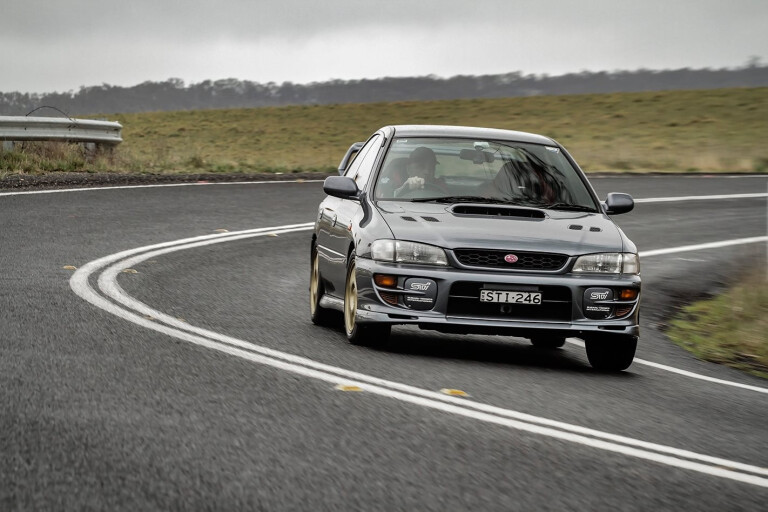
A news snippet in a weekend motoring section brought the WRX to Jim’s attention back in 1993. “I thought, ‘this is going to be a good little car’, so I went up to my local dealership and said, ‘When are these coming in?’ This was about September, October; he said it’d be next year sometime. I said, ‘Okay, can I give you a deposit?’ They were released in March ’94, and I picked this up on the 30th of March ’94.”
Click here for Subaru WRX Celebration: Introduction
The first-generation Subaru Impreza sedan and hatch superseded the compact Leone and adopted the EJ engine series that was already doing duty in the larger Legacy/Liberty.
The Audi Quattro had used its all-wheel drive and turbocharging to change rallying in the ’80s, but in the latter part of that decade it was the wolf-in-wool-blend Subaru Legacy RS Turbo that, for those in the know, delivered those technologies with everyman’s affordability.
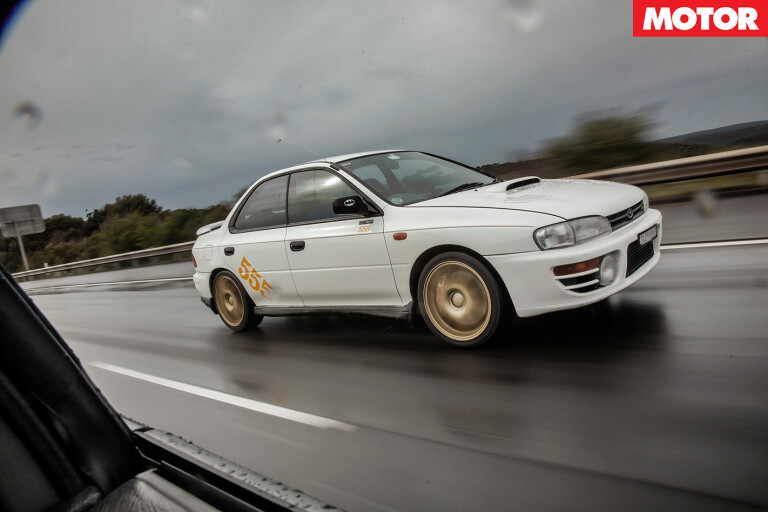
With the arrival of the WRX, the EJ20 turbo engine and all-wheel drivetrain of the RS Turbo were packaged in a smaller, lighter, soon-to-be World Rally weapon.
While the British American Tobacco-sponsored, 555-liveried Imprezas – Impretza if you were a Pommie rally commentator – blitzed WRC stages, Aussie tuners got to work modifying, in what soon became the WRX norm (a factor that made finding stock WRXs for this feature nearly impossible).

“Obviously, being brand new there was no aftermarket stuff available,” says Jim. (Seems hard to believe now, right?)
Rather, Parramatta dealership Marshalls, who sold him the car, offered a ‘555 pack’ which brought suspension upgrades, a larger exhaust and a cold air intake, making Jim’s MY94 one of the first modified WRXs in the land.

Since then, it’s been modded and modded again, evolving along with the WRX itself to the point that, today, it’s a bit of a grandpa’s axe. With more than 200kW at the wheels, it’s as quick around the track as the newest WRX here, a lightly modded MY09 – they both do 1:09s at Wakefield Park.
Jim’s car sits kart-flat and is sharper to steer and more racecar-like than any STi. The 2124cc stroker, with its old-school Garret 400s turbo, is laggy, but winds up to a furious top-end that delivers relentless shove through the close-ratio STi six-speed, backed by a whoosh and snuffle from the boxed pod air filter, and an exhaust note, via custom extractors, that’s more distinctly flat-four than WRX.
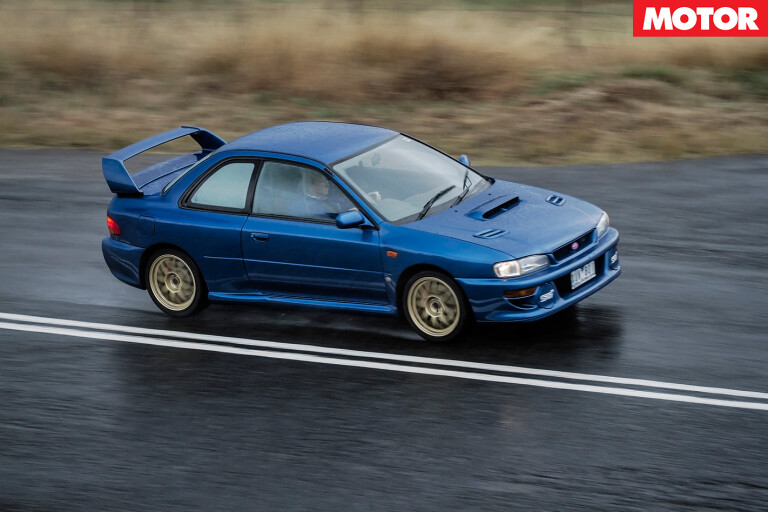
After a short time talking to Jim, it dawns on me – it wasn’t just the MY94, but his car that sparked the beginning of my WRX story. ‘BAT-555’ featured in brand-new, freshly modified form on the cover of the June 1994 issue of Fast Fours & Rotaries, which, to a 15-year-old me, was like a bible.
Eighteen years passed until I owned one. My ‘classic’ (first-gen) WRX of choice was an MY97 – it scored the race-style seats in place of the MY94-96’s flat, tweedy-trimmed items that looked like they were pinched from an Impreza LX.
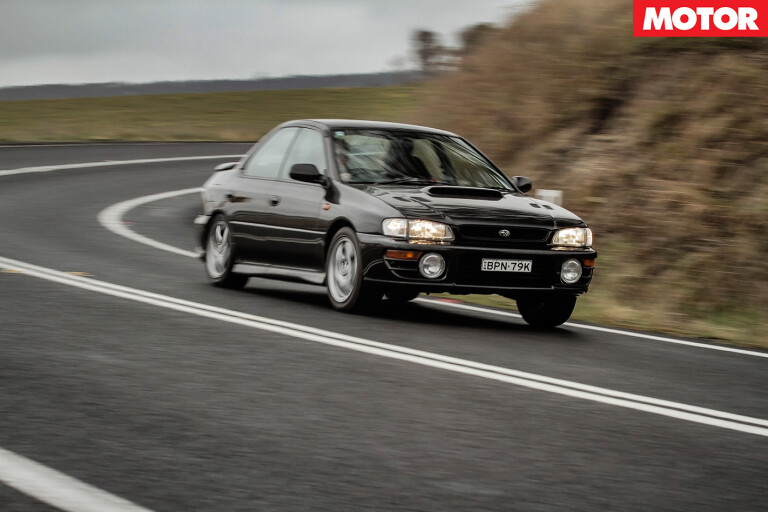
More importantly, though, the introduction of the new World Rally Car specifications in 1997 meant that for the MY97, the WRX could be offered with a smaller, more street-friendly IHI turbo in place of the larger, laggier Mitsubishi TD05H, which still resulted in a peak of 155kW, but torque rose 20, to 290Nm. (And yes, to whisper it is heresy, but the WRX once came with a Mitsubishi turbo, factory fitted.)
With these tweaks, and subtle styling updates, WRX mania took off – Subaru sold almost five times as many of ’em in 1997 as it did in 1996.
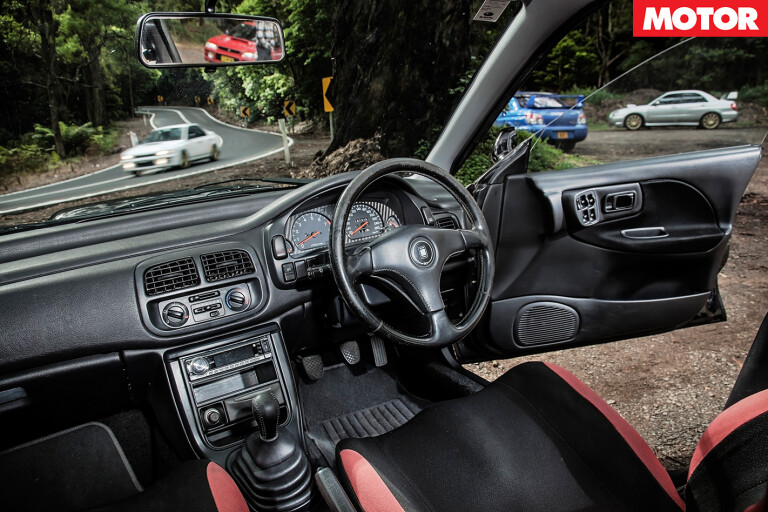
Also in favour of my chosen MY97 was that, among many molested early WRXs, this was the best car I could find. And, with 180,000-odd kays on the clock, it was barely run-in by Subie standards.
A first spin in my new, 15-year-old WRX suggested that the flimsy drive experience didn’t match the chunky look and all-wheel-drive promise, and during the first few weeks, the off-beat eggbeater exhaust thrum that followed me everywhere took some getting used to. Now, though, like many, I reckon that’s part of the appeal, along with unorthodox design features, such as the frameless door glass pioneered by the Leone.
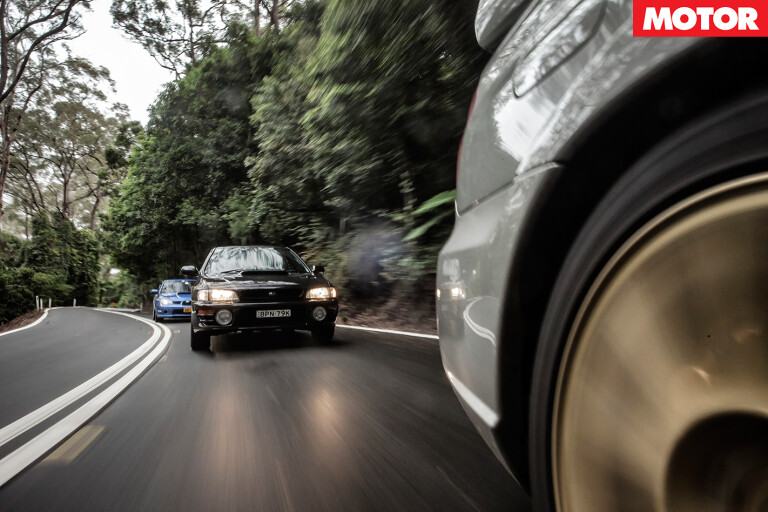
The immobiliser system fitted from MY97 models onwards proves little more than an annoyance in 2013 – who wants to steal a $10K Subaru? – insisting on re-arming with hideous regularity, although Jim tells me he had three theft attempts in the late-’90s ram-raider era, which made his aftermarket security system a must-have.
It takes a good, hard drive for the original WRX to reveal its greatness. Only then is it clear that age and kays haven’t wearied the 2.0-litre turbo boxer’s sprinting ability. The early EJ20 hits its stride at 3500rpm and delivers its kick until about 5500rpm but, thanks to a trim 1255kg kerb weight, it feels torquey from 2000rpm, though is a bit laggier than today’s turbos and nowhere near as smooth as later EJs.

Even when parked, my WRX’s permanent snout-up stance serves as a flashback to what was a common sight at green lights in the latter part of the 1990s, and tells of a decade-and-a-half of lightning-fast getaways.
In MOTOR, back in the day, a stock, black, limited edition MY97 press car – that proved to be an especially healthy example – hit 100km/h from rest in 5.26sec and ran the quarter in mid 13s (Fast Fours & Rotaries later put a boost gauge on it and found it several psi up on the standard 13psi figure).
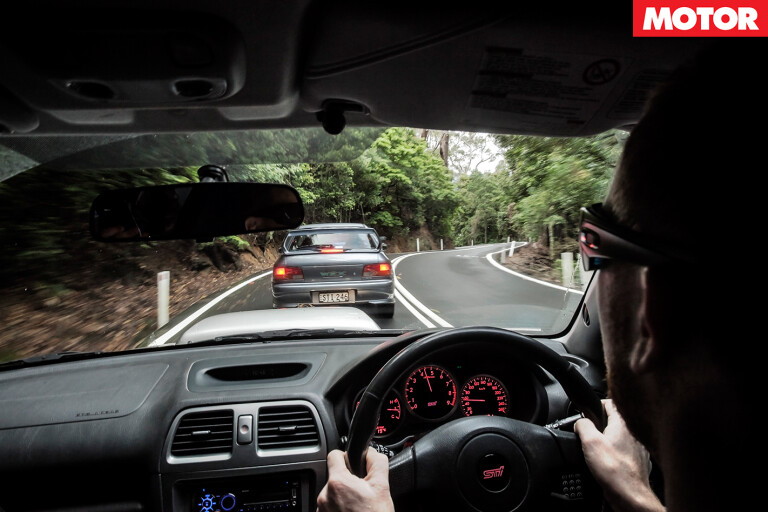
The early Rex’s playful rear-end and ability to spin an inside front wheel when exiting tight corners are proof that all-wheel drive doesn’t necessarily equal ruthlessly efficient speed at the expense of driver involvement.
The rest of the time the chassis remains unflappably poised and satisfyingly adjustable, which is perhaps the quality that helped the WRX win its first Bang for Your Bucks in ’98 (it also won in ’99, in STi form in ’02 and ’05, and in ’09).
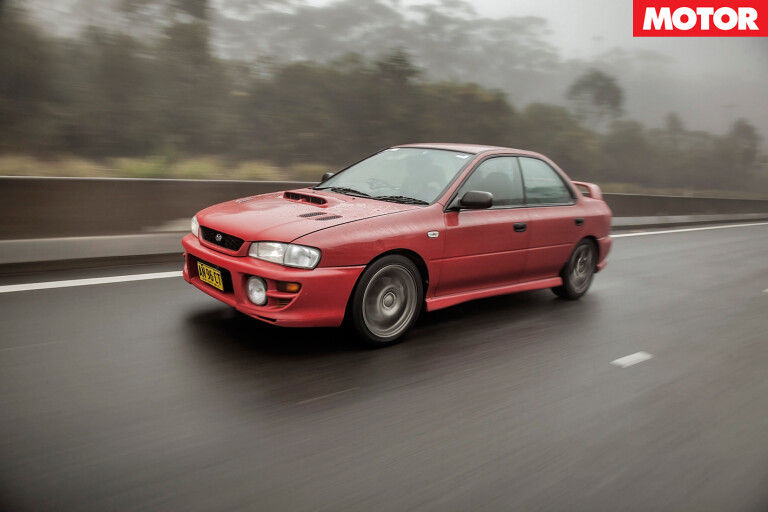
Classic WRX popularity peaked with the final MY99 and MY00 models, which brought the MY98’s updated, Forester-derived dash, as well as four-pot front brakes, a new front bar and a boot spoiler you could do your ironing on. Today, it’s the last of the line that’s the stuff of legend, and the one sought by enthusiasts.
Like me, MY99 owner Stephen seized upon the cost-effective performance offered by a classic WRX when he bought his red sedan two years ago, and the upgrade-me nature of your typical WRX club guy has meant most of his mods, including a cold air intake and a turbo-back exhaust, have come second-hand, and haven’t cost much either. Rough edges don’t diminish its appeal as an everyday-meets-track car, and mean Stephen and his WRX are in their element with dirt beneath the tyres.
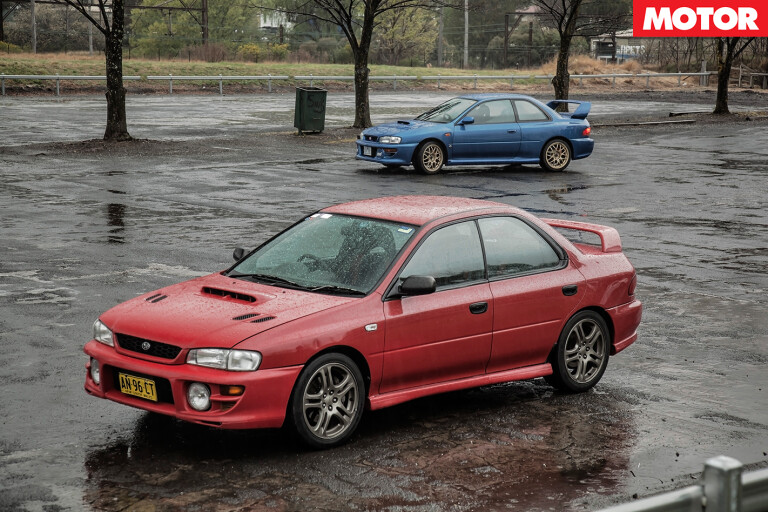
Precisely the opposite applies for Adam and his MY00 version 6 STi – neither modifications nor track days are on the agenda. He simply wants to enjoy his immaculate, limited-edition Subaru daily-driver on the road.
A larger, roller-bearing VF28 turbo pumps boosted air into horizontally-opposed cylinders in what is a slightly laggier set-up than that of a MY00 WRX. However, the free-spinning, full-fat top-end outweighs any complaints. Meanwhile, the hushed boxer rasp through the standard exhaust system lends his car a factory-fresh feel.

From the short-throw shifter of the close-ratio ’box to the immediacy of the steering and the firm ride, everything feels far tighter than in mine, which is as much a function of the STi specification as it is the fact that, at 90,000km, Adam’s STi has done half the number of kays.
The version 6 proves the perfect lead into the ultimate incarnation of the original WRX – the haloed Impreza 22B STi. Subaru Oz brought just five of them into the country in 1999 – 424 were built in total – and this one, with less than 7000km on the clock, remains a permanent part of its collection.
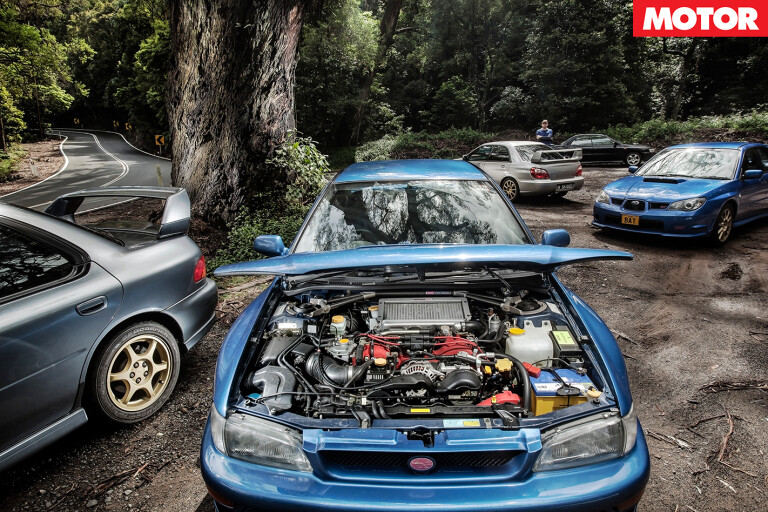
The 22B was the nearest thing to a World Rally Car for public roads, and was built in celebration of both consecutive WRC manufacturer’s titles (in 1995, ’96 and ’97) and Subaru’s 40th anniversary. Flared guards – that contributed to a total width increase of 80mm – cloaked hardware such as Brembo brakes, Bilstein dampers, a driver-controlled centre diff, and a hand-built, bored-out 2212cc boxer which, with its VF23 turbo, mustered 206kW and 363Nm.
In signature WRC Blue, arches bulging with deep-offset BBS alloys, it turns the heads of those who know it’s no version 5.

The drive experience is equally neck-snapping. From a flexible bottom end, it moves through the 3200rpm torque peak before exploding into a whooshing, raspy crescendo.
The low final drive, close-ratio ’box and racecar-taut ride – the rear suspension is rose-jointed – ensure the cabin and the driver buzz constantly, but the whole package has a togetherness that can be put down to its pedigree and pristine condition, and marks it as a fitting finale for the WRX that defined the legend.
Subaru WRX Celebration: Introduction
Subaru WRX Celebration: 2nd generation
Subaru WRX Celebration: 3rd generation
This feature first appeared in the December 2013 edition of MOTOR magazine.

COMMENTS